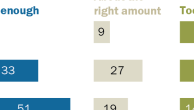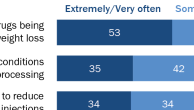The American Trends Panel (ATP), created by Pew Research Center, is a nationally representative panel of randomly selected U.S. adults living in households. Respondents who self-identify as internet users (representing 89% of U.S. adults) participate in the panel via monthly self-administered web surveys, and those who do not use the internet participate via telephone or mail. The panel is being managed by Abt SRBI.
Data in this report are drawn from three waves of the panel. Wave 1 was conducted March 19-April 29, 2014, among 3,308 respondents (2,901 by Web and 407 by phone). Wave 3 was conducted April 29-May 27, 2014, among 3,243 respondents (2,906 by Web and 337 by mail). Wave 6 was conducted Aug. 11-Sept. 3, 2014, among 3,278 respondents (2,923 by Web and 355 by mail).
Some analyses in this report include comparison of responses across more than one wave. For this analysis, respondents were only included if they completed Wave 1 and Waves 3-9 (Wave 2 was a non-response follow-up and not considered a full panel survey). The sample size for those who completed Wave 1 and Waves 3-9 was 1,955 respondents (1,815 by Web and 140 by phone/mail).
The margin of sampling error for the full sample of 3,308 respondents in Wave 1 is plus or minus 2.2 percentage points. The margin of sampling error for the 2,901 Web-only respondents in Wave 1 is plus or minus 2.3 percentage points. The margin of sampling error for the full sample of 3,243 respondents in Wave 3 is plus or minus 2.3 percentage points. The margin of sampling error for the full sample of 3,278 respondents in Wave 6 is plus or minus 2.3 percentage points. The margin of sampling error for the 1,955 respondents who completed Wave 1 and Waves 3-9 is plus or minus 3.4 percentage points.
All current members of the American Trends Panel were originally recruited from the 2014 Political Polarization and Typology Survey, a large (n=10,013) national landline and cellphone random digit dial (RDD) survey conducted Jan. 23 to March 16, 2014, in English and Spanish. At the end of that survey, respondents were invited to join the panel. The invitation was extended to all respondents who use the internet (from any location) and a random subsample of respondents who do not use the internet.11
Of the 10,013 adults interviewed, 9,809 were invited to take part in the panel. A total of 5,338 agreed to participate and provided either a mailing address or an email address to which a welcome packet, a monetary incentive and future survey invitations could be sent. Panelists also receive a small monetary incentive after participating in each wave of the survey.
The ATP data were weighted for single waves in a multi-step process that begins with a base weight incorporating the respondents’ original survey selection probability and the fact that some panelists were subsampled for invitation to the panel. Next, an adjustment was made for the fact that the propensity to join the panel varied across different groups in the sample. The final step in the weighting uses an iterative technique that matches gender, age, education, race, Hispanic origin and region to parameters from the U.S. Census Bureau’s 2012 American Community Survey. Population density is weighted to match the 2010 U.S. Decennial Census. Telephone service is weighted to estimates of telephone coverage for 2014 that were projected from the July-December 2013 National Health Interview Survey. It also adjusts for party affiliation using an average of the three most recent Pew Research Center general public telephone surveys, and for internet use using as a parameter a measure from the 2014 Survey of Political Polarization.
The ATP data were also weighted for respondents who completed Wave 1 and Waves 3-9. This process was similar to weighting for single ATP waves except an additional adjustment was made to account for nonresponse to individual waves.
Sampling errors and statistical tests of significance take into account the effect of weighting. The Hispanic sample in the American Trends Panel is predominantly native born and English speaking.
The Web component of Wave 1 had a response rate of 61% (2,901 responses among 4,753 Web-based individuals enrolled in the panel); the telephone component had a response rate of 70% (407 responses among 585 non-Web individuals enrolled in the panel). Taking account of the response rate for the 2014 Survey of Political Polarization (10.6%), the cumulative response rate for the first ATP wave is 3.6%.
The Web component of Wave 3 had a response rate of 61% (2,906 responses among 4,740 Web-based individuals enrolled in the panel); the mail component had a response rate of 61% (337 responses among 553 non-Web individuals enrolled in the panel). Taking account of the response rate for the 2014 Survey of Political Polarization (10.6%), the cumulative response rate for ATP Wave 3 is 3.5%.
The Web component of Wave 6 wave had a response rate of 62% (2,923 responses among 4,702 Web-based individuals enrolled in the panel); the mail component had a response rate of 64% (355 responses among 559 non-Web individuals enrolled in the panel). Taking account of the response rate for the 2014 Survey of Political Polarization (10.6%), the cumulative response rate for ATP Wave 6 is 3.6%.




